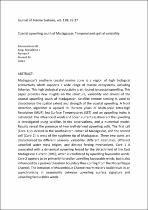JavaScript is disabled for your browser. Some features of this site may not work without it.
- ResearchSpace
- →
- Research Publications/Outputs
- →
- Journal Articles
- →
- View Item
| dc.contributor.author |
Ramanantsoa, JD

|
|
| dc.contributor.author |
Krug, Marjolaine J

|
|
| dc.contributor.author |
Penven, P

|
|
| dc.contributor.author |
Rouault, M

|
|
| dc.contributor.author |
Gula, J

|
|
| dc.date.accessioned | 2018-08-02T12:34:14Z | |
| dc.date.available | 2018-08-02T12:34:14Z | |
| dc.date.issued | 2018-02 | |
| dc.identifier.citation | Ramanantsoa, J.D. et al. 2018. Coastal upwelling south of Madagascar: Temporal and spatial variability. Journal of Marine Systems, vol. 178: 29-37 | en_US |
| dc.identifier.issn | 0924-7963 | |
| dc.identifier.issn | 1879-1573 | |
| dc.identifier.uri | https://www.sciencedirect.com/science/article/pii/S092479631730249X | |
| dc.identifier.uri | https://doi.org/10.1016/j.jmarsys.2017.10.005 | |
| dc.identifier.uri | http://hdl.handle.net/10204/10341 | |
| dc.description | Copyright: 2017 Elsevier. Due to copyright restrictions, the attached PDF file only contains the abstract of the full text item. For access to the full text item, please consult the publisher's website. | en_US |
| dc.description.abstract | Madagascar's southern coastal marine zone is a region of high biological productivity which supports a wide range of marine ecosystems, including fisheries. This high biological productivity is attributed to coastal upwelling. This paper provides new insights on the structure, variability and drivers of the coastal upwelling south of Madagascar. Satellite remote sensing is used to characterize the spatial extent and strength of the coastal upwelling. A front detection algorithm is applied to thirteen years of Multi-scale Ultra-high Resolution (MUR) Sea Surface Temperatures (SST) and an upwelling index is calculated. The influence of winds and ocean currents as drivers of the upwelling is investigated using satellite, in-situ observations, and a numerical model. Results reveal the presence of two well-defined upwelling cells. The first cell (Core 1) is located in the southeastern corner of Madagascar, and the second cell (Core 2) is west of the southern tip of Madagascar. These two cores are characterized by different seasonal variability, different intensities, different upwelled water mass origins, and distinct forcing mechanisms. Core 1 is associated with a dynamical upwelling forced by the detachment of the East Madagascar Current (EMC), which is reinforced by upwelling favourable winds. Core 2 appears to be primarily forced by upwelling favourable winds, but is also influenced by a poleward eastern boundary flow coming from the Mozambique Channel. The intrusion of Mozambique Channel warm waters could result in an asynchronicity in seasonality between upwelling surface signature and upwelling favourables winds. | en_US |
| dc.language.iso | en | en_US |
| dc.publisher | Elsevier | en_US |
| dc.relation.ispartofseries | Worklist;21165 | |
| dc.subject | Coastal upwelling | en_US |
| dc.subject | Ekman transport | en_US |
| dc.subject | East Madagascar Current | en_US |
| dc.subject | Numerical model | en_US |
| dc.subject | Sea Surface Temperature | en_US |
| dc.subject | South of Madagascar | en_US |
| dc.title | Coastal upwelling south of Madagascar: Temporal and spatial variability | en_US |
| dc.type | Article | en_US |
| dc.identifier.apacitation | Ramanantsoa, J., Krug, M. J., Penven, P., Rouault, M., & Gula, J. (2018). Coastal upwelling south of Madagascar: Temporal and spatial variability. http://hdl.handle.net/10204/10341 | en_ZA |
| dc.identifier.chicagocitation | Ramanantsoa, JD, Marjolaine J Krug, P Penven, M Rouault, and J Gula "Coastal upwelling south of Madagascar: Temporal and spatial variability." (2018) http://hdl.handle.net/10204/10341 | en_ZA |
| dc.identifier.vancouvercitation | Ramanantsoa J, Krug MJ, Penven P, Rouault M, Gula J. Coastal upwelling south of Madagascar: Temporal and spatial variability. 2018; http://hdl.handle.net/10204/10341. | en_ZA |
| dc.identifier.ris | TY - Article AU - Ramanantsoa, JD AU - Krug, Marjolaine J AU - Penven, P AU - Rouault, M AU - Gula, J AB - Madagascar's southern coastal marine zone is a region of high biological productivity which supports a wide range of marine ecosystems, including fisheries. This high biological productivity is attributed to coastal upwelling. This paper provides new insights on the structure, variability and drivers of the coastal upwelling south of Madagascar. Satellite remote sensing is used to characterize the spatial extent and strength of the coastal upwelling. A front detection algorithm is applied to thirteen years of Multi-scale Ultra-high Resolution (MUR) Sea Surface Temperatures (SST) and an upwelling index is calculated. The influence of winds and ocean currents as drivers of the upwelling is investigated using satellite, in-situ observations, and a numerical model. Results reveal the presence of two well-defined upwelling cells. The first cell (Core 1) is located in the southeastern corner of Madagascar, and the second cell (Core 2) is west of the southern tip of Madagascar. These two cores are characterized by different seasonal variability, different intensities, different upwelled water mass origins, and distinct forcing mechanisms. Core 1 is associated with a dynamical upwelling forced by the detachment of the East Madagascar Current (EMC), which is reinforced by upwelling favourable winds. Core 2 appears to be primarily forced by upwelling favourable winds, but is also influenced by a poleward eastern boundary flow coming from the Mozambique Channel. The intrusion of Mozambique Channel warm waters could result in an asynchronicity in seasonality between upwelling surface signature and upwelling favourables winds. DA - 2018-02 DB - ResearchSpace DP - CSIR KW - Coastal upwelling KW - Ekman transport KW - East Madagascar Current KW - Numerical model KW - Sea Surface Temperature KW - South of Madagascar LK - https://researchspace.csir.co.za PY - 2018 SM - 0924-7963 SM - 1879-1573 T1 - Coastal upwelling south of Madagascar: Temporal and spatial variability TI - Coastal upwelling south of Madagascar: Temporal and spatial variability UR - http://hdl.handle.net/10204/10341 ER - | en_ZA |






